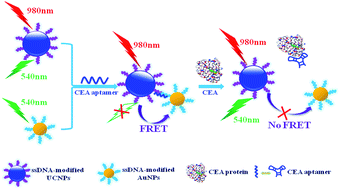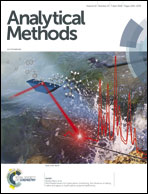An ultrasensitive fluorescence aptasensor for carcino-embryonic antigen detection based on fluorescence resonance energy transfer from upconversion phosphors to Au nanoparticles
Abstract
A novel fluorescence resonance energy transfer (FRET)-based aptasensor was proposed for carcino-embryonic antigen (CEA) detection utilizing NaYF4:Yb3+, Er3+ upconversion nanoparticles (UCNPs) and gold nanoparticles (Au-NPs) as the energy donor and acceptor, respectively. The FRET process occurs when the single-stranded DNA modified UCNPs and Au-NPs are linked together by the CEA aptamer, which leads to the fluorescence quenching of UCNPs. However, the presence of CEA splits the above fluorescence-suppressed Au-NPs–aptamer–UCNPs sandwich complex, resulting in the fluorescence recovery of UCNPs. The recovery of fluorescence intensity is linearly correlated to the concentration of CEA in the range of 0.05–2.0 ng mL−1, enabling the detection and quantification of CEA. Such a sandwich-type FRET-based assay possesses a low limit of detection (0.02 ng mL−1) and satisfactory selectivity and reproducibility, indicating that this biosensor is applicable for the trace detection of the CEA protein.



 Please wait while we load your content...
Please wait while we load your content...